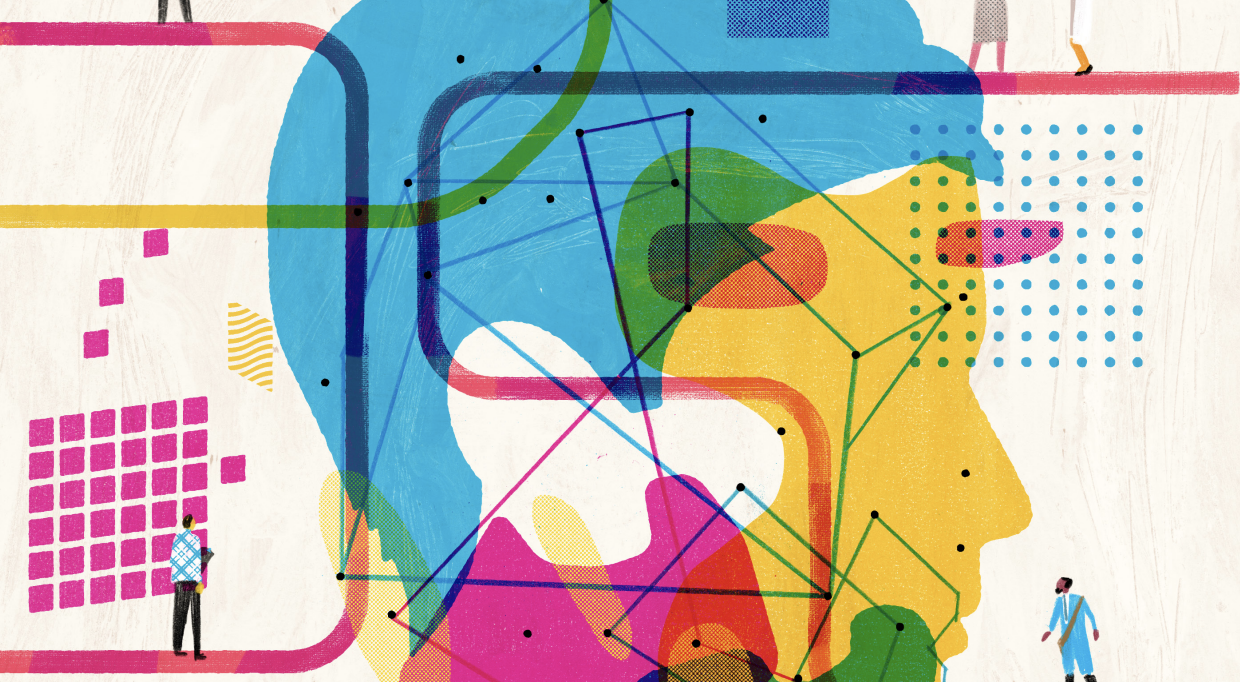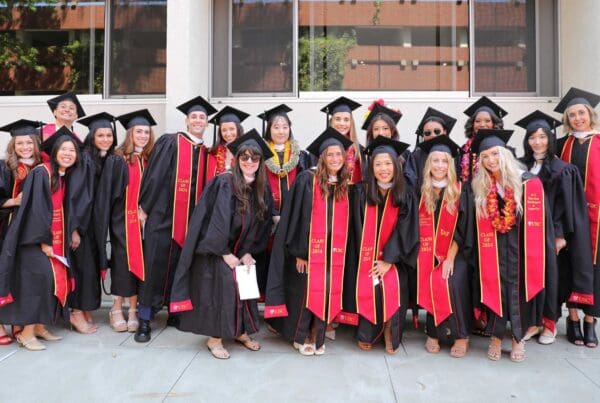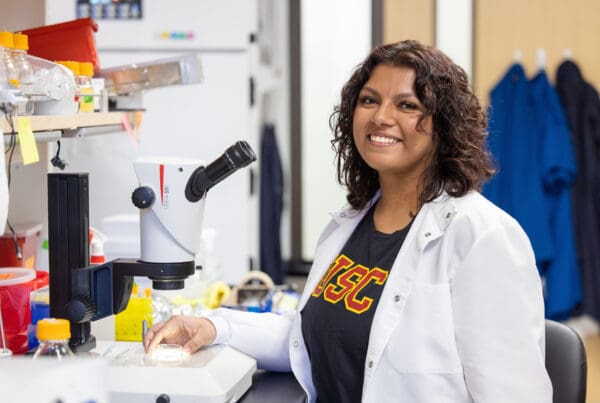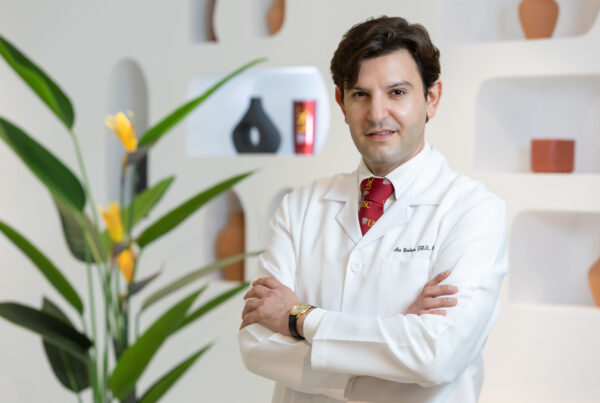Virtual reality headsets, robotic pets and digital personal assistants are all part of the curriculum in Gero 506, a technology-focused course exploring how digital devices can help provide older adults with therapy, companionship, support and more. Students got a firsthand look at how seniors are using these interactive tools during a recent field trip to the Front Porch Center for Innovation and Wellbeing. Later in the semester, they will conduct their own research to identify additional areas where technology can provide solutions.
“As the boomers age — especially the younger ones — I think we’re going to want a lot more innovative, convenience-driven type technology,” says Leslie Hellow, a student in the Master of Aging Services Management program. She enrolled in the class because of the huge role she sees technology playing in serving the older adult population. “I think rolling our sleeves up and really seeing what’s out there, and then seeing what the gaps are, will be interesting — and meaningful, too,” Hellow says.
Along with courses that delve into the power of the mind-body connection or the different role individual genetics can play in nutrition, the gerontechnology class is an example of the cutting-edge curriculum and diversity of approaches to the study of aging at the USC Leonard Davis School. When the school was founded in 1975, initial classes focused on core topics related to biology, sociology, psychology and policy. Today, an increasing number of degree programs and course offerings prepare students for a changing and vibrant field.
“Our gerontological imagination has expanded to include entrepreneurship, corporate consulting, health care, nutrition, exercise science, technology and more,” says Senior Associate Dean Maria Henke. “Our graduates are being called upon to advance solutions in areas that were not even considered decades ago, and our ever-evolving course catalog both anticipates and reflects that.”
Professor and Dean Emeritus Ed Schneider credits Henke with keeping the curriculum relevant by introducing innovative programs like the new Master in Senior Living Hospitality program. “It is really a new ball game,” he says. “Learning how to serve older adults in retirement settings will create careers for thousands of students.”
The school’s curriculum also empowers students to address still-critical issues around aging policy, biology and service. As part of their coursework, they have detailed which neighborhood crosswalks are least safe for seniors, designed diets to meet specific nutritional needs and developed apps to combat social isolation.
Making It Personal
When it comes to teaching the physiology of development and aging, Schneider takes a personal approach, requiring students to actively participate during discussions. “I think reading is the least productive way to learn something,” he says.
His emphasis on interaction extends to a class assignment in which students are tasked with interviewing older adults about their individual health conditions and concerns. Master of science student Stephen Santos recorded a conversation with his 72-year-old uncle, and the experience proved invaluable.
“I probably would have never had this type of conversation with him in such an intimate way had it not been for this class and assignment,” he says. “It’s also helpful to begin speaking with older people as opposed to coming into future jobs thinking we [already] know it all. By starting this practice early, we will be able to refine these skills and remember that there is no one-size-fits-all approach to working with such a diverse population with varied needs.”
Generational Shifts
Course curricula also address how aging impacts young adults. Stacks of skateboards line the walls of Professor John Walsh’s lecture hall during his popular general education class, Gero 315g, A Journey into the Mind. He connects with his undergraduate students by playing current music and passing out homemade cookies. He also pays extra attention to what is going on in the 20-year-old brain.
“These are freshmen and sophomores, so I spend an enormous amount of time talking about the psychological and psychiatric issues they are confronting — what psychiatry refers to as the affective disorders. I go over clinical depression, bipolar disease, ADHD, ADD and anxiety, because these are things some of them are experiencing right now,” Walsh says.
Walsh also developed Gero 508, The Mind and Body Connection Through the Lifespan, which introduces the beneficial effects of yoga, diet, exercise and music therapy and asks students to design intervention programs that make use of them.
In addition, he recognizes that today’s young adults are not following the life course trajectory that some members of his generation did, leaving home and becoming financially independent at age 18. As a result, he added instruction in his adult development classes to encourage students to save and invest for their retirements and to prepare to assist aging parents.
“It’s important for them to think about not just their own futures, but [that of] their parents, especially if they’re moving home,” he said. “I get feedback from students who had never thought of this stuff. But they are 20-year-olds, so why would they?”
Future Forward
Professor Susan Enguidanos pushes her pupils to plan even further ahead. In her course Gero 420, Social and Psychological Aspects of Death and Dying, she assigns the task of filling out an advance directive, a legal document that expresses an individual’s wishes regarding medical care should they be unable to speak for themselves. Students must also help a parent or other family member complete one.
“I definitely knew it was something that should get done, but I had no motivation until this class,” says Adam Drazan, a junior in the Bachelor of Science in Lifespan Health program. “Now I’m excited about the opportunity to get it going and have in writing what I want, and what a family member would want.”
Despite their relative youth, Drazan and his classmates appreciate how applicable they have found their gerontology courses to their everyday lives. When asked whether studying aging sets the students apart from their peers on campus, junior Raelynn Kelley, who is also majoring in lifespan health, answered with an amusing anecdotal observation: Gerontology students wear more practical shoes. “It’s something funny — I noticed more people wearing tennis shoes and more practical shoes,” she says. “It’s something really bizarre, but not as many heels, not as many shoes you look at and say, ‘Oh, wow, you’ll have orthopedic problems 20 years down the line.’”
Her response is perhaps proof that students have taken their lessons about the importance of prevention to heart. But those same shoes can also serve as a symbol of the many paths their varied gerontology journeys will allow them to travel.
Illustration by Keith Negley





